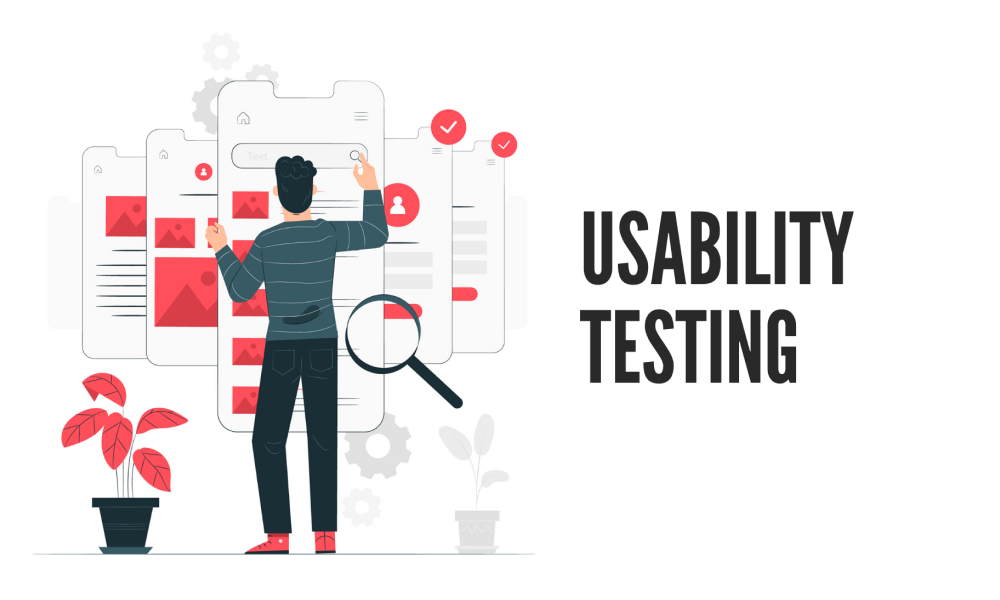One common approach to user experience research is usability testing. A researcher (referred to as a “facilitator” or a “moderator”) guides a participant through a series of activities, often involving one or more designated user interfaces, in a usability-testing session. The researcher watches the individual closely and takes notes as they finish each activity.
The purpose of conducting usability tests is to find ways to enhance the user experience by identifying potential sources of confusion and pain spots along the customer journey. One of the main goals of usability testing is to determine how well a product works in practise by seeing how quickly and easily a user can accomplish a set objective.
Why usability test?

When creating a product or service, usability testing is essential, but it is especially important for items that will have an interface or involve user contact. The goals of usability testing includes:
Finding problems with the product or service’s design:
Among the many purposes of usability testing, this one may be the simplest. Design flaws like muddled interfaces, missing directions, or broken features can be found by watching how customers use the product or service.
Real users will swiftly expose these issues, which may not be noticeable during design or even internal testing. You can save time and energy in the long term by finding these problems early and fixing them before releasing the product or service to more people.
Uncovering opportunities to improve:
In addition to spotting current issues, usability testing also shows where improvements could be made. On occasion, consumers may propose alterations or additions that the design group has overlooked.
When used to improve the product or service, these insights can help a great deal in satisfying the demands and expectations of the target audience. Designers can achieve a better grasp of users’ needs and wants by attentively listening to their comments during usability testing, which ultimately results in a more refined and user-friendly product.
Learning about the target user’s behavior and preferences:
During usability testing, designers can observe real-life interactions between the product or service and its intended consumers. As designers, we can learn a lot about our users’ behaviors, expectations, trouble spots, and preferences just by watching how they interact with our products.
Because of this insight, designers can better cater the user experience to the demographic they’re trying to reach. Usability testing also helps validate assumptions and design choices, which is important for making sure the end product meets user needs.
Elements of usability testing

Although there is a wide variety of usability tests, the three main components of every given test are the facilitator, the tasks, and the participant.
Facilitator
The individual taking the test is escorted by the facilitator. She guides the participant, addresses their inquiries, and then asks further questions. Without inadvertently influencing the participant’s behavior, the facilitator strives to guarantee that the test yields high-quality, legitimate data. Training is necessary to achieve this delicate equilibrium.
Tasks
The tasks that make up a usability test are designed to mimic those that a user could encounter in their daily lives. Research questions and the kind of usability testing determine the level of specificity and open-endedness in the inquiries.
In usability testing, the task wording is crucial. A psychological phenomenon known as priming occurs when even little changes in the wording of a task might lead participants to misunderstand the task or alter their performance on the task.
Participants may receive verbal instructions (read aloud by the facilitator) or written instructions (provided on work sheets) to complete the activity. Reading the instructions aloud is a common exercise that we have participants do. The researcher may keep track of the user’s current activity, which aids note-taking, and the participant is more likely to read the instructions thoroughly.
Participant
The participant must possess a genuine understanding and experience with the product or service that is being studied. This can indicate that the customer is making actual use of the service or product. Also, even if the participant isn’t currently using the product, he may have similar wants or come from a similar background to the target user group.
The “think-aloud method” refers to the practice of having participants think aloud while conducting usability tests. As they go about their work, the facilitator may have the participants record their thoughts and deeds. The rationale, objectives, thoughts, and actions of the participants are to be comprehended by means of this method.
Types of usability testing
Qualitative vs. quantitative
Qualitative and quantitative approaches are both valid in usability testing.
Qualitative usability testing:
Researching actual user experiences with a product or service is the primary goal of qualitative usability testing. To find issues with the user experience, qualitative usability testing is the way to go. Compared to quantitative usability testing, this method is far more prevalent.
Quantitative usability testing:
The primary goal of quantitative usability testing is to gather data that characterizes the user’s journey. Task success and time on task are two of the most typical metrics obtained in quantitative usability testing. The most effective method for gathering benchmarks is quantitative usability testing.
Depending on the study type, the minimum number of participants required for a usability test could differ. We suggest utilising five people for a standard qualitative usability research of one user group; this should be more than enough to find most of the most common product issues.
Remote vs. in-person testing
Because they are more cost- and time-efficient than in-person research, remote usability testing are becoming increasingly popular. Moderated and unmoderated remote usability testing are the two main categories.
Remote moderated usability tests:
The procedure of remote moderated usability tests is highly comparable to that of in-person research. The facilitator continues to engage in conversation with the participant and gives her assignments.
Nevertheless, the participant and facilitator are situated in separate physical places. Typically, screen-sharing applications such as Skype or GoToMeeting can be utilised to conduct moderated examinations.
Remote unmoderated remote usability tests:
There is no substitute for face-to-face or moderated testing when it comes to remote, unmoderated usability testing. In order to provide written assignments to participants, researchers utilize specialized online remote-testing tools.
The individual then works independently, at her own pace, to do the assigned tasks. All of the directions and any additional questions for the task are provided by the testing tool. The researcher gets a session recording and metrics like task success when the participant finishes the test.
Cost of usability testing

It is common practice to give participants a few hundred dollars as incentives, yet simple, “discount” usability tests can be inexpensive. The easy study will require three days of your time (if you already know how to execute it and have access to participants), and the testing session can take place in a conference room:
- Day 1: Plan the study
- Day 2: Test the 5 users
- Day 3: Analyze and use the results to inform your suggestions for the next layout.
In contrast, more costly research is occasionally necessary, with the most extensive studies costing several hundred thousand dollars.
Things that add cost include:

- Testing with different user groups (or personas)
- Requiring a real usability lab or focus group space where others may watch
- Utilisation of high-tech tools, such as eye trackers
- Trial and error with different designs
- Comprehensive report outlining the results.
- Testing on a global scale in many nations
- Evidence-based research
Although it is not always the case, the return on investment (ROI) for more complex investigations can nevertheless be really substantial.





